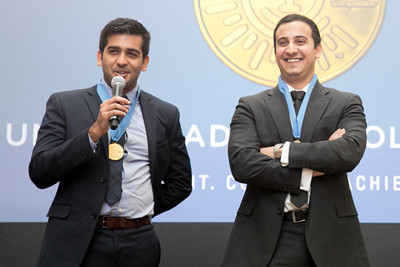



The first snows have fallen, a whiff of hot wings and barbecue mix in the frigid air, and you’ve sworn off at least one coworker since “wear-your-team-jersey-to-work day” at the office. It can only mean one thing: the playoffs are here. Each week millions of Americans join in the quest for football glory as they gather around flat screen TVs and pitchers of cold beer to root for their favorite teams. The sport they are watching has changed considerably since its early days when the forward pass was considered a trick play and helmets were optional. Here are some of the patented inventions that have helped along the way.
Note: This article is part of an ongoing series detailing some of the Inventors Eye staff’s favorite patents. For each article, the writer selects their five favorite patents under a given theme. This list is from USPTO public affairs specialist Jon Abboud.
Helmet
U.S. Patent No. 2,293,308
Legend has it that the first football helmet was made out of moleskin by a local shoemaker at the request of a U.S. Naval Academy player whom doctors had warned might suffer “instant insanity” if he took another hit to the head. Thankfully, helmets have come a long way since, and their importance has garnered significant attention in recent years. The design detailed in U.S. 2,293,308 is an early predecessor to the one fans are familiar with today. Innovations like extra padding, face guards, visors, and even a coach-to-player radio system continue to shape helmet design in the 21st century.
Ten Yard Line
U.S. Patent No. 1,684,566
Sideline officials have long used a 10-yard length of chain to measure if a team has advanced the ball far enough to earn a first down. This is where the popular phrase “moving the chains” comes from, and we have patents like U.S. 1,684,566 to thank for it. Moses H. Winkler’s 1927 invention of the Ten Yard Line was one of the earliest devices patented for such use. Winkler hoped his invention would prevent what he called “ugly situations” from arising over disputed calls from the officials. Accomplishing that particular goal remains elusive, but most football fans don’t seem to mind.
Football Trousers
U.S. Patent No. 1,573,212
Football players have worn a variety of different trousers over the decades. Invented by William P. Whitley and Robert C. Zuppke, the trousers shown in U.S. 1,573,212 were one of several designs. These trousers allowed for the insertion of pads which were intended to protect a player’s lower body and abdomen. While they may not have been the most stylish pants around, they probably saved at least a few players from being carted off to the locker room on a stretcher.
Athletic Shoe and Cleat Therefor
U.S. Patent No. 1,782,569
Today, many professional football players wear custom made shoes that might look more at home in a modern art exhibit than on the football field. However, in the 1930s most players could afford only a single pair of shoes, and wearing the wrong ones spelled disaster in rain or snow. So what were players to do? One solution was provided by U.S. 1,782,569, a design which allowed the wearer to screw interchangeable spikes of varying length into threaded metal receptacles on the soles of a single pair of shoes.
Interactive System Allowing Real Time Participation
U.S. Patent No. 5,860,862
Fantasy football lets fans combine dreams of managing a professional team with the thrill of real-time interactive participation. Fantasy team “owners” fill a roster with professional players during a preseason draft and can make trades and transactions throughout the season. Once the season (and the ritualistic trash-talking) begins, individual player statistics are converted to points in real-time, head-to-head matchups with other fantasy teams. Rewards for a hard won season range from simple bragging rights among friends to lucrative cash winnings. The system detailed in U.S. 5,860,862 is not quite as intricate as the smart phone applications and other fantasy football services available today, but it certainly helped pave the way for the recent explosion of this popular trend.
The USPTO gives you useful information and non-legal advice in the areas of patents and trademarks. The patent and trademark statutes and regulations should be consulted before attempting to apply for a patent or register a trademark. These laws and the application process can be complicated. If you have intellectual property that could be patented or registered as a trademark, the use of an attorney or agent who is qualified to represent you in the USPTO is advised.